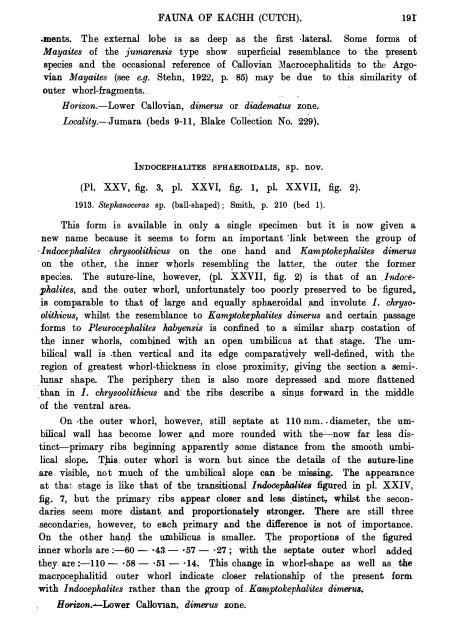ialontolngia ndita,
ialontolngia ndita,
ialontolngia ndita,
You also want an ePaper? Increase the reach of your titles
YUMPU automatically turns print PDFs into web optimized ePapers that Google loves.
FAUNA OF KACHH (CUTCH). 19!<br />
.ments. The external lobe is as deep · as the first lateral. Some forms of<br />
Mayaites of the jumarensis type show superficial resemblance to the present<br />
species and the occasional reference of Callovian Macrocephalitids to the Argovian<br />
Mayaites (see e.g. Stehn, 1922, p. 85) may be due to this similarity of<br />
outer whorl-fragments ...<br />
Horizon.-Lower Callovian, dimerus or diadematus zone.<br />
Locality.- -Jumara (beds 9-11, Blake Coll ction No. 229).<br />
INDOCEPHALITES SPHAEROIDALIS, sp. nov.<br />
(PI. ·xxv, fig. 3, pi. XXVI, fig. 1, pi. XXVII, fig. 2).<br />
1913. Stephanoceras sp. (ball-shaped) ; Smith, p. 210 (bed 1).<br />
This form is available in only a single specimen · but it is now given a<br />
new name because it seems to form an important 'link between the group of<br />
· lndocephalites chrysoolithicus on the one hand and Kamptokephalites dimerus<br />
on the other, the inner whorls resembling the latter, the outer the former<br />
species. The suture-line, however, (pl. XXVII, fig. 2) is that of an Jndocephalites,<br />
and the outer whorl, unfortunately too poorly preserved to be · figured,<br />
is comparable to that of large and equally sphaeroidal _and involute I. chrysoolithicus<br />
whilst the resemblance to Kamptokephalit dimerus and certain passage<br />
_<br />
forms . to Pleurocephalites habyensis is co;nfined _to a similar sharp costation of<br />
the inner whorls, combined with an open up1bilicus at that . stage. The umbilical<br />
wall is then vertical and its edge comparatjvely well-defined, . with the<br />
region of greatest whorl-thickness in close proximity, giving the section a semi-<br />
_lunar shape. The periphery then is also more depressed a:pd more flattened<br />
than in I.. chrysoolithicus and the ribs describe a sinus forward in _ the middle<br />
of the ventral area.<br />
On -the outer whorl, however, still _ septate at 110 mm .. diameter, the umbilical<br />
wall has become lower nd more rounded with thnow far less distinct--primary<br />
ribs _ beginning app rently some distance from the smooth umbilical<br />
slope. T}ris outer whorl is worn but since the details of the suture-line<br />
.are visible, not much of the umbilical slope cn . be missing. The · appearanceat<br />
that stage is like that of the ..transitional lndoeepites figured in pi. XXIV,<br />
fig. 7, but the pri)nary ribs appear closer and less _distinct7 whilst the secondaries<br />
seem more distant_ and proportionately stronger.. There are still three<br />
.secondaries, however, to each primary and the difference is not of importance.<br />
On the . other han.d the umbilicus is smaller.. 'l;he proportions of the figured<br />
inner whorls are :-60 - ·43. - ·57 - ·27 ; with the septate outer whorl add.ed<br />
they. a:::e .:-1 10 - ·58 - ·51 - ·14. This change in whorl-shape as well as . the<br />
macrpcephalitid outer whorl indicate closer relationship of the present . form<br />
with lndocephalites rather than the group . of . Kf;tmptokephalites dimerU&.<br />
Horizon .. ..__Lower CalJovian, dimerus zone.
















